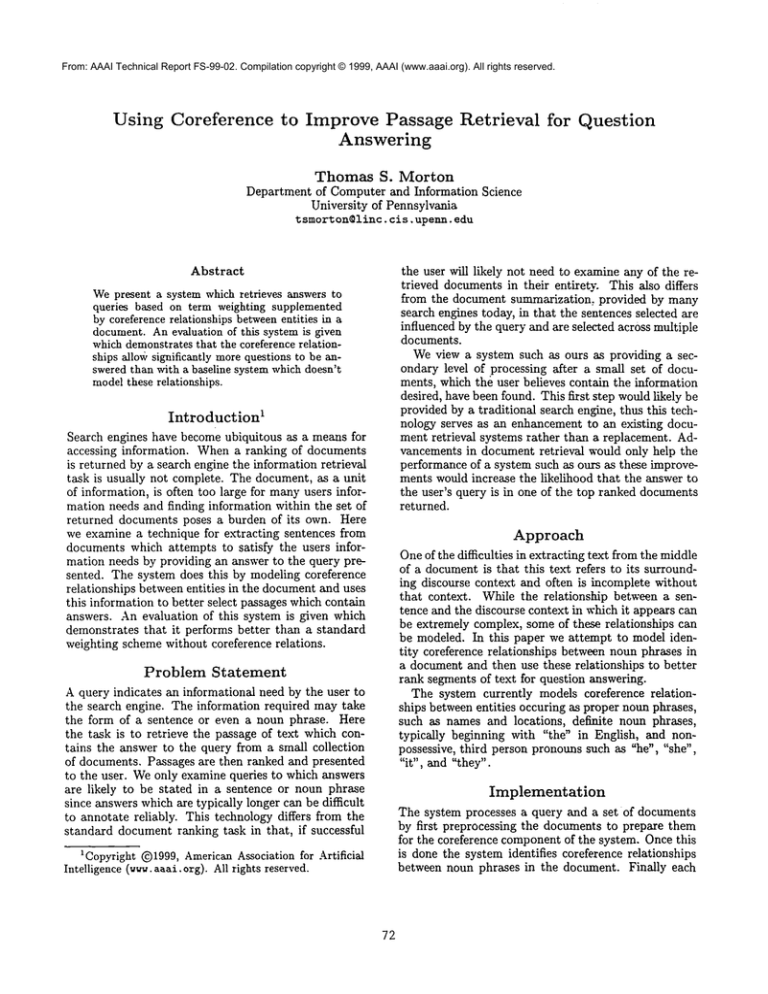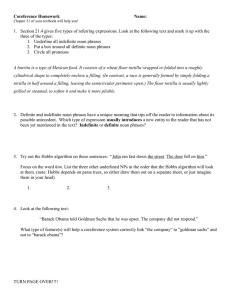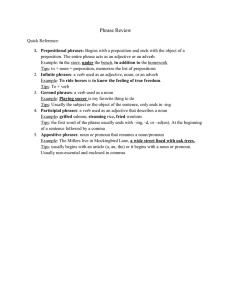
From: AAAI Technical Report FS-99-02. Compilation copyright © 1999, AAAI (www.aaai.org). All rights reserved.
Using Coreference
to Improve Passage Retrieval
Answering
for Question
Thomas
S. Morton
Department of Computer and Information Science
University of Pennsylvania
t smorton©linc,
cis,upenn,edu
Abstract
the user will likely not need to examine any of the retrieved documents in their entire~: This also differs
from the document summarization, provided by many
search engines today, in that the sentences selected are
influenced by the query and are selected across multiple
documents.
Weview a system such as ours as providing a secondary level of processing after a small set of documents, which the user believes contain the information
desired, have been found. This first step wouldlikely be
provided by a traditional search engine, thus this technology serves as an enhancement to an existing document retrieval systems rather than a replacement. Advancements in document retrie~-al would only help the
performance of a system such as ours as these improvements would increase the likelihood that the answer to
the user’s query is in one of the top ranked documents
returned.
Wepresent a system which retrieves answers to
queries based on term weighting supplemented
by coreference relationships betweenentities in a
document.An evaluation of this system is given
which demonstratesthat the coreference relationships allov~ significantly morequestions to be answered than with a baseline system which doesn’t
modelthese relationships.
1Introduction
Search engines have become ubiquitous as a means for
accessing information. Whena ranking of documents
is returned by a search engine the information retrieval
task is usually not complete. The document, as a unit
of information, is often too large for manyusers information needs and finding information within the set of
returned documents poses a burden of its own. Here
we examine a technique for extracting sentences from
documents which attempts to satisfy the users information needs by providing an answer to the query presented. The system does this by modeling coreference
relationships between entities in the document and uses
this information to better select passages which contain
answers. An evaluation of this system is given which
demonstrates that it performs better than a standard
weighting scheme without coreference relations.
Approach
Oneof the difficulties in extracting text from the middle
of a documentis that this text refers to its surroundLug discourse context and often is incomplete without
that context. While the relationship between a sentence and the discourse context in which it appears can
be extremely complex, some of these relationships can
be modeled. In this paper we attempt to model identity coreference relationships between noun phrases in
a document and then use these relationships to better
rank segments of text for question answering.
The system currently models coreference relationships between entities occuring as proper noun phrases,
such as names and locations, definite noun phrases,
typically beginning with "the" in English, and nonpossessive, third person pronouns such as "he", "she",
"it", and "they".
Problem
Statement
A query indicates an informational need by the user to
the search engine. The information required may take
the form of a sentence or even a noun phrase. Here
the task is to retrieve the passage of text which contains the answer to the query from a small collection
of documents. Passages are then ranked and presented
to the user. Weonly examine queries to which answers
are likely to be stated in a sentence or noun phrase
since answers which are typically longer can be difficult
to annotate reliably. This technology differs from the
standard document ranking task in that, if successful
Implementation
The system processes a query and a set of documents
by first preprocessing the documents to prepare them
for the coreference component of the system. Once this
is done the system identifies coreference relationships
between noun phrases in the document. Finally each
1Copyright (~)1999, AmericanAssociation for Artificial
Intelligence (w~v.aaai.org). All rights reserved.
72
sentence is ranked based on its terms and the terms of
noun phrases coreferent with it.
Preprocessing
Determining coreference between noun phrases requires
that the noun phrases in the text have been identified.
This processing begins by preprocessing the HTML
to determine likely boundaries between segments of
text, sentence detecting these segments using a sentence
detector described in (Reynar & Ratnaparkhi 1997),
and tokenizing those sentences using a tokenizer described in (Reynar 1998). The text can then be part
of speech tagged using the tagger described in (Ratnaparkhi 1996) and finally noun phrases are determined
using a maximumentropy model trained on the Penn
Treebank(Marcus, Santorini, & Marcinkiewicz 1994).
The output of Nymble(Bikel et al. 1997), a named entity recognizer which determines which words are people’s names, organizations, locations, etc., is also used
for determining coreference relationships.
Coreference
Once preprocessing is completed the system iterates
through each of the noun phrases to determine if they
refer to a noun phrase which has occured previously.
Only proper noun phrases, definite noun phrases, and
non-possessive third person pronouns are considered.
Proper nouns phrases are determined by the part of
speech assigned to the last word in the noun phrase. A
proper noun phrase is considered coreferent with a previously occuring noun phrase if it is a substring of that
noun phrase excluding abbreviations and words which
are not proper nouns. A noun phrase is considered definite if it begins with a the determiner "the" or begins
with a possessive pronoun or a past participle verb. A
definite noun phrase is considered coreferent with another noun phrase if the last word in the noun phrase
matches the last word in a previously occuring noun
phrase. The mechanism for resolving pronouns consists
of a maximumentropy model which examines two noun
phrases and produces a probability that they co-refer.
The twenty previously occuring noun phrases are considered as well as the possibility that the pronounrefers
to none of these noun phrases. The pair with the highest probability are considered coreferent or the pronoun
is left unresolved whenthe model predicts that the most
likely outcome is that the pronoun doesn’t refer to any
of the proceeding noun phrases. The model considers
the following features:
1. The category of the noun phrase being considered as
determined by the named entity recognizer.
2. Howmany noun phrases occur between the candidate
noun phrase and the pronoun.
3. How many sentences occur between the candidate
noun phrase and the pronoun.
4. Whichnoun phrase in a sentence is being referred to
(first, second, ...).
5. In which noun phrase in a sentence did the pronoun
occur (first, second,...).
6. Which pronoun is being considered.
7. Are the pronoun and the noun phrase compatible in
number.
8. If the candidate noun phrase is another pronoun is it
compatible with the referring pronoun.
9. If the candidate noun phrase is another pronoun is it
the same as the referring pronoun.
The model is trained on nearly 1200 annotated examples of pronounswhichrefer or fail to refer to previously
occurring noun phrases.
Segment
Ranking
Segments for both systems are scored and ranked based
on the sum of the idf weights(Salton 1989) for each
unique term which occurs in the segment and also
occurs in the query. The idf weights are computed
based on the documents found on TRECdiscs 4 and
5 (Voorhees & Harman 1997). No additional score
given for tokens occuring more than once in a segment.
Segments for the baseline system are 250 byte sequences of text. The coreference enhanced system ranks
each sentences detected during the preprocessing phase.
In the coreference enhanced system, terms which occur
in a coreferential noun phrase are also considered to
have occured in that s%~ment.
Evaluation
For the evaluation of the system fifty queries were selected from a collection of actual queries presented to
an online search en~o-ine2. Queries were selected based
on their expressing the users information need clearly,
their being likely answered in a single sentence, and
non-dubious intent.
The queries were then presented to Altavista 3 and
the top 20 ranked documents were retrieved. The documents were then processed by the baseline system as
well as the coreference system and the top ten ranked
text segments were presented to the user. Since some
of the documents retrieved were very long the baseline
system was used to select the best segment and then
the coreference system was applied to a 10K window
surrounding that segment.
Each system presented the user with the top 10
ranked segments. Segments for both systems were limited to 250 bytes. In the coreference s~tem equal
amounts of text from each side of the sentence were
added if the sentence was less than 250 bytes and the
sentence was truncated if it was more than 250 bytes.
The output of the systems was evaluated by a novice
user and the systems were scored using the following
metric:
2Electric Monk, ~.electricmonk.com
3Altavista, ~-~rw.altavista, corn
of the coreference relations which are recovered from
the text. Specifically we would like to model quoted
speech contexts which would allow us to consider first
and second person pronouns.
,~ lo-(r~.k(q)-l)
~q:l
I0
n
Here n is the numberof questionsprocessedand
rank(q)
is theranking
of thefirstsegment
to answer
question
q. Usingthismetricthesystems
performed
as
follows:
Baseline I Coreference
I
30.66%
44.89%
Discussion
Text extraction and ranking while similar in its information retrieval goals with document ranking appears
have very different properties. While a document can
often stand alone in its interpretation the interpretation
of a sentence is dependent on the context in which it appears. The modeling of the discourse context gives the
coreference based system an advantage over a baseline
model in situations where referring expressions, which
provide little information outside of their discourse context, can be related to the query. The most extreme
example of this being the use of pronouns.
In some cases the baseline system had a segment
which answered the question ranked higher than the
coreference system. This is because a 250 byte segment might span multiple sentences where the coreference system ranked single sentences. However, for all
questions which were answered by the baseline system
the coreference system also provided an answer. Overall the baseline was able to provide answers to 17 of the
50 questions and the coreference system answered 26.
Since no attempt was made to ensure that an answer
existed in the retrieved documentcollection it is likely
that for some questions none of the top 20 documents
retrieved contained an answer.
Related
Work
Other work employs coreference for document summarization such as (Baldwin & Morton 1998) for single
documents and (Mani & Bloedorn 1997) for multiple
documents. These works differ in that they evaluate
summaries based on a users ability to determine a documentsrelevance to a query rather than a specific information need. (Hirschman et al. 1999) reports improved
performance on a system to take standardized reading
comprehension tests for 3rd to 6th graders when coreference relationship were included.
Conclusion
Our system demonstrates that the automatic recognition of coreference relationships in text can improve
performance in passage retrieval for question answering.
The system has been tested on text retrieved from the
World Wide Web and performed substantially
better
than the a baseline system which did not model coreference. In the future we would like to extend the scope
74
References
Baldwin,
B., and Morton, T. 1998. Dynamic
coreference-based summarization. In Proceedings of
the Third Conference on Empirical Methods in Natural LanguageProcessing.
Bikel, D.; Miller, S.; Schwartz, R.; and Weischedel,
R. 1997. Nymble: a high-performance learning namefinder. In Proceedings of the Fifth Conference on Applied Natural LanguageProcessing.
Hirschman, L.; Light, M.; Breck, E.; and Burger, J. D.
1999. Deep read: A reading comprehension system. In
Proceeding of the 37th Annual Meetin of the Association for Computational Linguistics.
Mani, I., and Bloedorn, E. 1997. Multi-document summarization by graph search and matching. In Proceeding of the Fourteenth National Conference on Artificial
intelligence (AAAI-97):
Marcus, M.; Santorini, B.; and Marcinkiewicz, M.
1994. Building a large annotated corpus of english: the
penn treebank. Computational Linguistics 19(2):313330.
Ratnaparkhi,
A. 1996. A Maximum Entropy Part
of Speech Tagger. In Brill, E., and Church, K., eds.,
Conference on Empirical Methods in Natural Language
Processing.
Reynax, J. C., and Ratnaparkhi, A. 1997. A maximum
entropy approach to identifying sentence boundaries.
In Proceedings of the Fifth Conference on Applied Natural LanguageProcessing, 16--19.
Reynar, J. 1998. Topic Segmentation: Algorithms
and Applications. Ph.D. Dissertation, University of
Pennsylvania.
Salton, G. 1989. Automatic text processing: the transformation, analysis, and retrieval of information by
computer. Addison-Wesley Publishing Company, Inc.
Voorhees, E. M., and Harman, D. 1997. Overview
of the fifth Text REtrieval Conference (TREC-5).
Proceedings of the Fifth Text REtrieval Conference
(TREC-5), 1-28. NIST 500-238.








